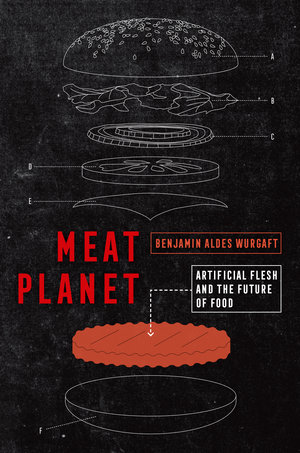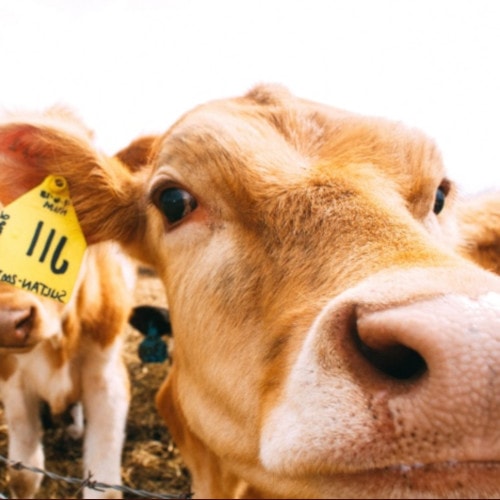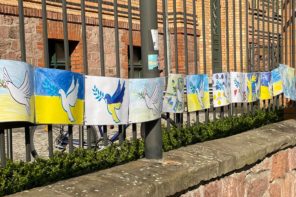If the proponents of cultured meat are to be believed we might be soon headed towards a future in which bioreactors replace, or at least exist alongside, industrial abattoirs, and a large percentage of the meat produced for mass consumption comes from technologically tinkered cells derived via biopsies from animals rather than their slaughtering. At a juncture where the world is reeling under a zoonotic pandemic, and meat consumption has once again come under scrutiny, perhaps the image of what is at times (not uncontroversially) labeled “clean meat” lends itself to even more curiosity than usual.
Benjamin Aldes Wurgaft’s Meat Planet: Artificial Flesh and the Future of Food is a book about this emerging technology of cultured or in vitro meat, a wonderfully crafted journey into its hype and hope laden world.

The story begins in 2013, the year the first cultured beef burger (which cost no less than 300,000 dollars), created by the Dutch scientist Mark Post, was unleashed amidst much fanfare. Wurgaft watches this international media event, as it unfolds in London, from his home in Los Angeles. From 2013 to 2018 Wurgaft follows various actors in the business of cultured meat, tacking across sites from San Francisco to Maastricht, as the promise fuelled story of this biotechnology evolves at a, perhaps unexpectedly, sluggish pace. The author cleverly marries his own reflections on the various roadblocks encountered as he wishes to partake (as a scholar) in the high stakes world of cultured meat with insights into the workings of an industry nourished mostly by venture capital and sustained by intellectual property regimes (there is discussion of alternate models as represented by the non-profit New Harvest, founded by Jason Methany, which support the open source sharing of information—this, however, is an exception). And most times it seems that the promissory, being as it is the most fluent speech genre of speculative capital, tends to overshadow “all other kinds of speech, including debate about what is desirable in our food system” (p. 50, emphasis added)—and this is where Wurgaft’s book, to me, makes its most incisive contribution. Putting the more deliberate temporality of ethnography to good use he forces us to stop and think instead of getting unmindfully caught up in the hype. Promise and unbridled hope in cultured meat is, however, reigned in by doubt; doubt that primarily arises out of the two core issues in the cultured meat movement — “finding a serum-free growth medium and producing three dimensional or “thick” tissue” (p. 65). The story of cultured meat is, like most speculative biotechnologies, a story suspended in hope and hype, promise and doubt.
The six chapters titled “Future”, “Memento”, “Copy”, “Philosophers”, “Maastricht” and “Parting/Gathering” form the meaty crux of the text; these are conceptually dense, philosophically motivated discussions of the place of (technologically mediated) meat (production) in our natural-cultural worlds. The wide ranging treatment of meat’s past and possible future in our shifting worlds is especially enjoyable and illuminating. Having set the stage by familiarising us with the capaciousness of the concept of meat in the chapter titled “Meat” towards the beginning of the text, the author approaches the concerns of some of cultured meat’s proponents to “naturalise” it from a different, more critical vantage. In one possible reading of the biological anthropologist Richard Wrangham’s work meat consumption is crucially tied to what made us human in the first place and cultured meat, by extension, is but the next evolutionary leap. However, although some paleoanthropologists might view meat as merely instrumental, which Wurgaft reads as an extension of the reductive location of our humanity in its characterisation as Homo faber, there are other non-instrumental ways in which meat is implicated in our worlds—here the discussions of anthropologists Marshall Sahlins and Claude Levi-Strauss, as well as the reflections on what counts as kosher meat are significant detours. What is, however, most important to be noted is that cheaply available meat and the present architecture of its mass production has only been a reality for the last hundred years or so. What might be the best way out of this unsustainable, and, needless to say, cruel practice? It isn’t easy to draw an uninterrupted evolutionary arc between the projected past of our meat loving ancestors and the projected future of cultured meat without considering the peculiarity of the changes wrought by industrial meat production and the widespread availability of cheap meat. Instead of attempting to naturalise our present meaty appetites in order to envision the place of cultured meat in our futures it perhaps behoves us to ask “what stories about us and our appetites will our creations [here, lab grown meat in particular] tell?” (p.120).
Cultured meat, besides struggling with the feasibility of its mass production, also struggles to fulfil another promise. The future success of cultured meat, it is often thought, rests on its ability of mimicking the texture and bite of conventional meat, something that sets it apart from mining other sources of protein such as insects or using plant based meat substitutes (sophisticated plant based substitutes are widely available but can’t claim to mimic meat in quite the same way). Mimicking conventional meat, however, is a labour intensive technicality as well as revelatory of the strategic choices that we make regarding which forms of meat we wish for to be made available (the celebrated lab grown burger is a strategic as well as technical feat). Mimesis, as Wurgaft shows, rests in the laboratory nervously alongside plasticity, or the ability of tissue to take diverse forms. Although the processes in the laboratory might be read as “extending” those found in nature, via mimesis, it also “provides such an obvious opportunity for flesh to take on new forms that only an intense attachment to the familiar ones could keep cultured meat within the paradigm of imitating nature” (p. 119). Here, through the mediary of the philosopher and intellectual historian Hans Blumenberg, Wurgaft draws our attention to the fraught line between imitation and innovation. This is exactly the tension which the bio-artists Oron Catts and Ionat Zurr wish to tap into through their use of tissue culture to generate what they call “semi-living” creatures. Catts and Zurr have identified “an aesthetic potential in biotechnology….Biotechnology might unwittingly perform one of art’s functions and transform our way of seeing the world —more specifically, our way of seeing the meaning of biological life” (p. 179-180). Their work stresses the protean potential of life (processes) and rejects its mechanistic reduction; reducing life and its processes to a mechanism which yields itself to control and optimisation is a claim that ultimately drives the cultured meat movement, and one whose analytically reductive character comes with consequences. Ironically, the journey of the cultured meat movement itself might be borne by such plasticity, as the author muses at one point (p. 175), in resulting probably as it does from the growing disillusionment with the feasibility of other biotechnologies such as regenerative medicine, clean fuel etc.
Cultured meat might have as its impetus a significant moral thrust, i.e. to reduce animal suffering, but Wurgaft ventures further to ask what moral questions might cultured meat, were it to realise the abolition of animal agriculture, raise.
Peter Singer, and his brand of utilitarianism, provides the philosophical grist for these conversations. Utilitarianism’s moral philosophical pegs rest on the the reduction of suffering and the maximisation of happiness. However, if animals were to be freed from the instrumental ends they often serve us and were to exist as creatures with their own ends, “…creature[s] whose individual experience[s]…should matter” (p.133), how might the debate on maximising happiness, a goal utilitarianism wishes to accomplish, be transformed and in turn transform us. The book ends with the invocation of “an experiment in ethical futures”— the “pig in the backyard” (p. 188-189) scenario. This is a likely path that the cultured meat movement might tread in the future and one that the author invests his hope in. In this scenario a pig frolics in a city yard, where it lives among and interacts with the people who feed and play with it. A certain amount of cells are removed from the pig every week through a biopsy to produce just enough meat for the community’s consumption. It is a scenario which, while not fully liberating pigs from their role as a “source” of meat, also brings together “intimacy, community and…difference” (p. 188). A veritable utopia which redirects a critical lens onto our present interactions with animals and meat.
Wurgaft manages to skilfully foreground the political brew within which new technologies emerge and implores us to ask tougher questions that the hype and hope around them often tend to obscure. The writing weaves philosophical, anthropological and historical discussions with science fiction and poetry with distinct flair and comes peppered with a healthy dose of witticisms. Although, at times, some might feel they’ve bitten off more than they can chew, the book is definitely well worth wading through.
Feature Image (cropped) by pixnio.com









